
Gazpacho or gaspacho, also called Andalusian gazpacho, is a cold soup and drink made of raw, blended vegetables. It originated in the southern regions of the Iberian peninsula and spread into other areas. Gazpacho is widely eaten in Spain and Portugal, particularly during hot summers, since it is refreshing and cool.

Bouillabaisse is a traditional Provençal fish soup originating in the port city of Marseille. The word is originally a compound of the two Provençal verbs bolhir and abaissar.

Salmorejo, sometimes known as ardoria or ardorío, is a traditional soup originating from Andalusia, southern Spain, made of tomato, bread, extra virgin olive oil and garlic. Normally, the tomatoes are skinned and then puréed with the other ingredients. The salmorejo is served cold and may be garnished with diced Spanish ibérico ham and diced hard-boiled eggs.

Salvadoran cuisine is a style of cooking derived from the nation of El Salvador. The indigenous foods consist of a mix of Amerindian cuisine from groups such as the Lenca, Pipil, Maya Poqomam, Maya Chʼortiʼ, Alaguilac and Cacaopera peoples. Many of the dishes are made with maize (corn). There is also heavy use of pork and seafood. European ingredients were incorporated after the Spanish conquest.

Sopa de mondongo is a soup made from diced tripe slow-cooked with vegetables such as bell peppers, onions, carrots, cabbage, celery, tomatoes, cilantro, garlic or root vegetables. The dish is generally prepared in former Spanish colonies in Latin America, Caribbean, and in the Philippines.
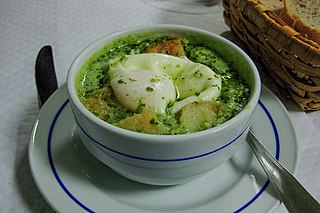
Açorda is a typical Portuguese dish composed of thinly sliced bread with garlic, finely chopped coriander, olive oil, vinegar, water, white pepper, salt and poached eggs. Throughout Portugal, Açordas have significant variations, most notably in the Alentejo, where an Açorda, also called Açorda Alentejana, can be considered a soup, whereas in other regions of Portugal it has a consistency similar to a bread paste. Other variations can have shrimps or codfish.

The cuisine of Algeria is influenced by Algeria's interactions and exchanges with other cultures and nations over the centuries. It is based on both land and sea products. Conquests or demographic movement towards the Algerian territory were two of the main factors of exchanges between the different peoples and cultures. The Algerian cuisine is a mix of Arab, Berber, Turkish and French roots.
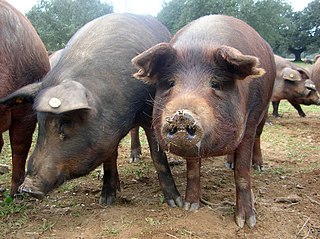
Extremadura, Spain is known for its different ways of preparing the Iberian pork and mutton. The main characteristics of the traditional Extremaduran cuisine are its simplicity, its lack of clutter and its low cost. It is also a cuisine reflecting a generous spirit, for many of its preparations used to be cooked in large pots to share with visitors, friends, and neighbors. The resulting dishes are eaten with local bread.

Flaki or flaczki is a traditional Polish tripe stew. It is one of the many Polish soups, which represent an important part of Polish cuisine. Along with bigos, żurek, and pierogi, it is one of the most notable specialities in Polish cuisine. Its name is derived from its main ingredient: thin, cleaned strips of pork tripe.

Bread soup is a simple soup that mainly consists of stale bread. Variations exist in many countries, and it is often eaten during Lent. Both brown and white bread may be used.
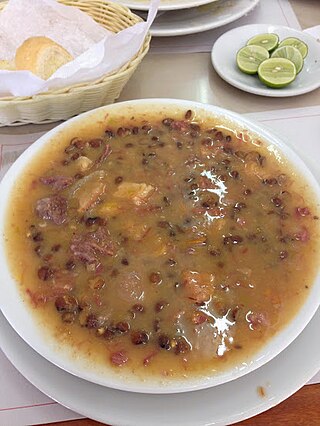
Sopa de guandú con carne salada is a Colombian dish. Sopa de guandú con carne salada is a traditional dish of Colombia's Atlántico department, but many variations are prepared in the Caribbean reigon of Colombia, including the departments of Sucre and Córdoba.

Garlic soup is a type of soup using garlic as a main ingredient. In Spanish cuisine, sopa de ajo is a traditional garlic soup made with bread and egg poached in chicken broth, and laced with garlic and sherry.
Sopa de gato is a simple soup typical of the classic cuisine of southern Spain. It is a very thick sopa (soup) served hot. It is a suitable dish for the winter months. Typical ingredients in the dish's preparation include water, bread, oil, garlic and salt.
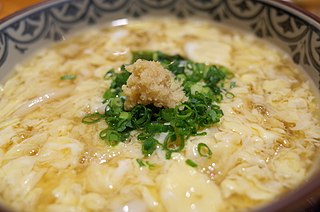
Egg drop soup, also known as egg flower soup, is a Chinese soup of wispy beaten eggs in chicken broth. Condiments such as black or white pepper, and finely chopped scallions and tofu, are commonly added to the soup. The soup is made by adding a thin stream of beaten eggs to the boiling broth in the final moments of cooking, creating thin, silken strands or flakes of cooked egg that float in the soup.
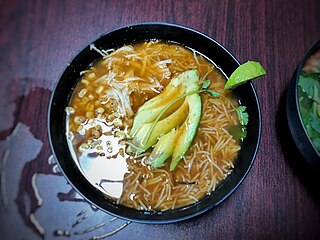
Sopa de fideo, also referred to as sopita de fideo, is a stock-based noodle soup that is a part of the cuisines of Spain, Mexico, and Cavite, a province in the Philippines.













